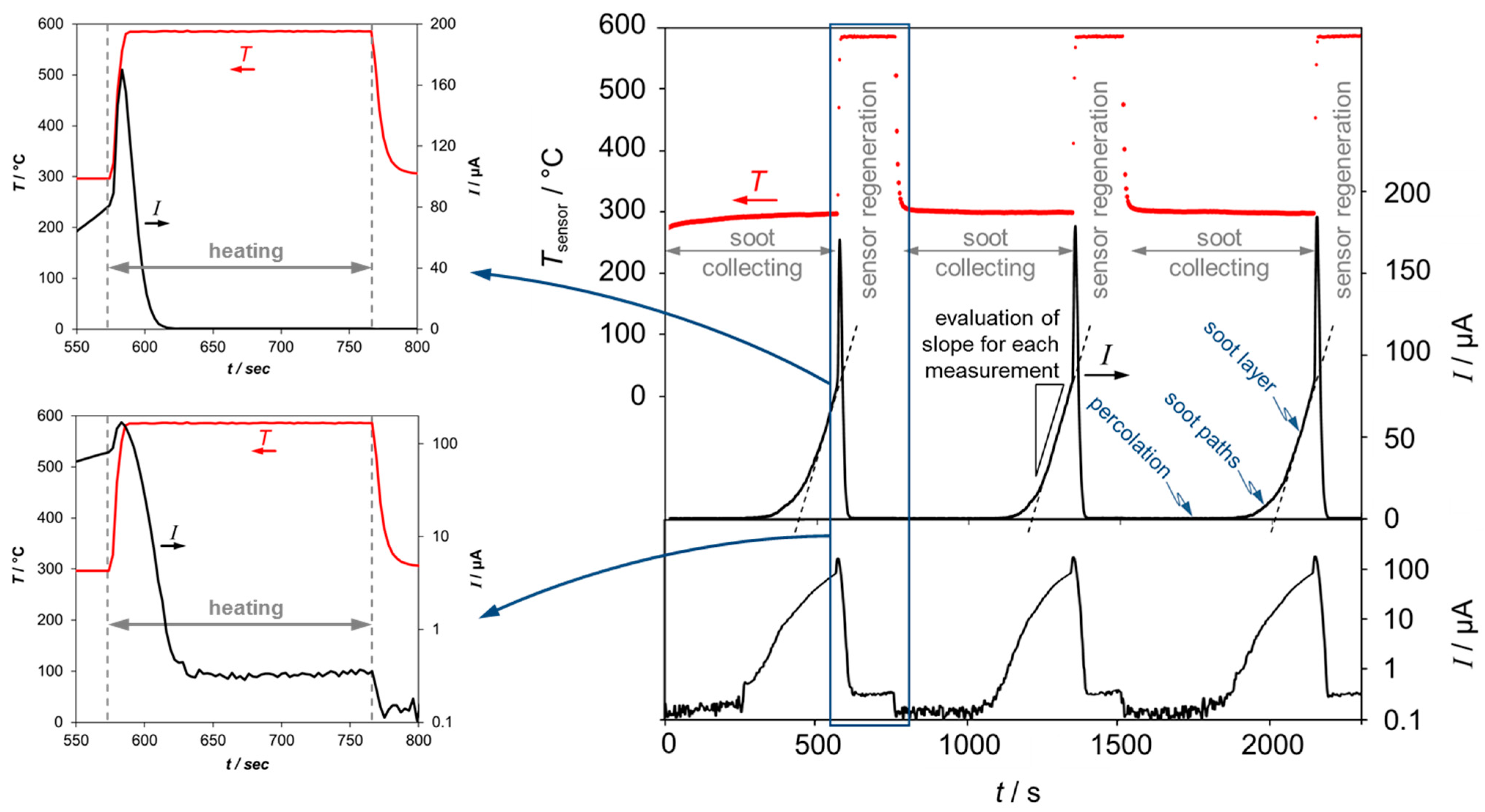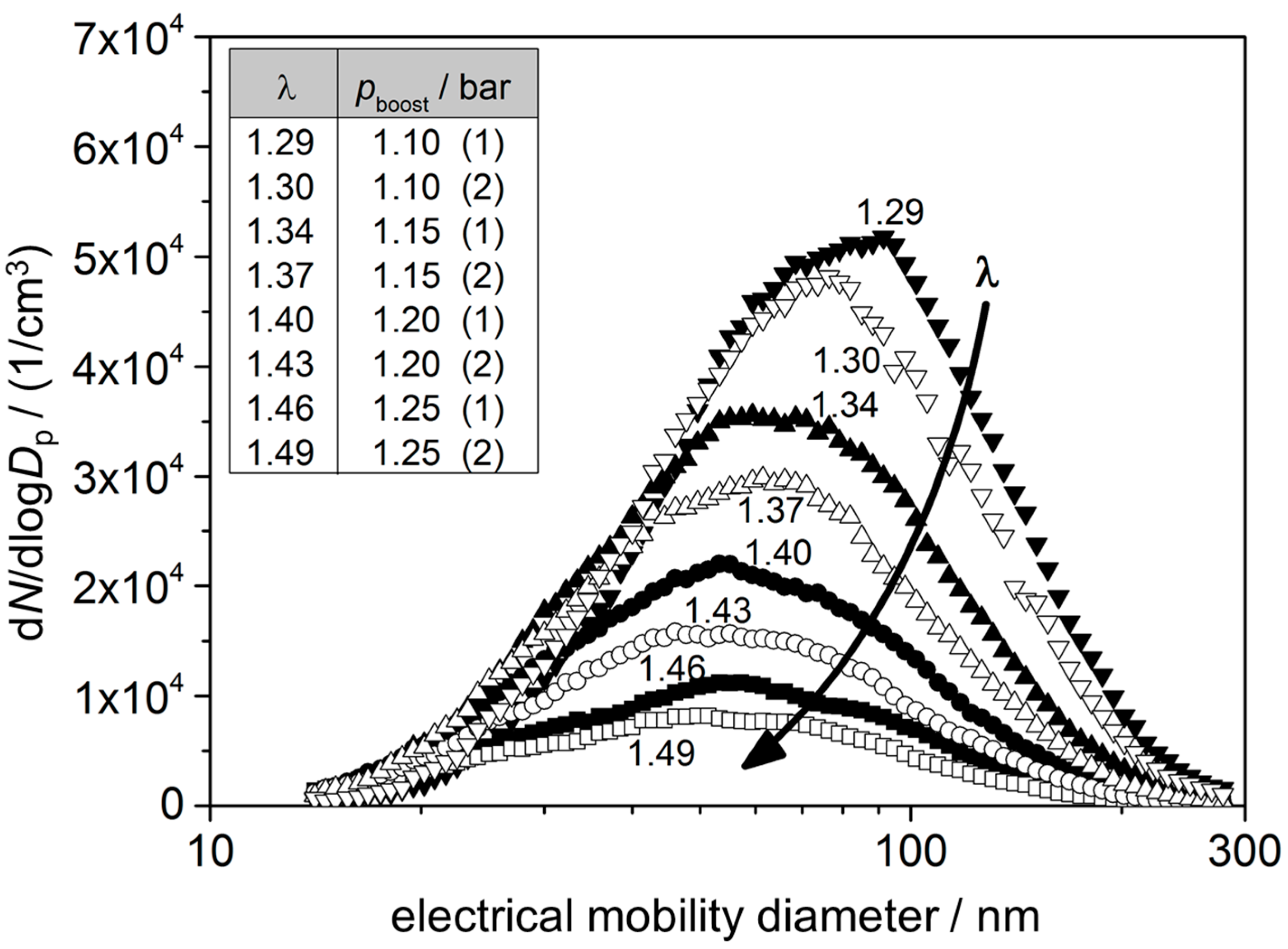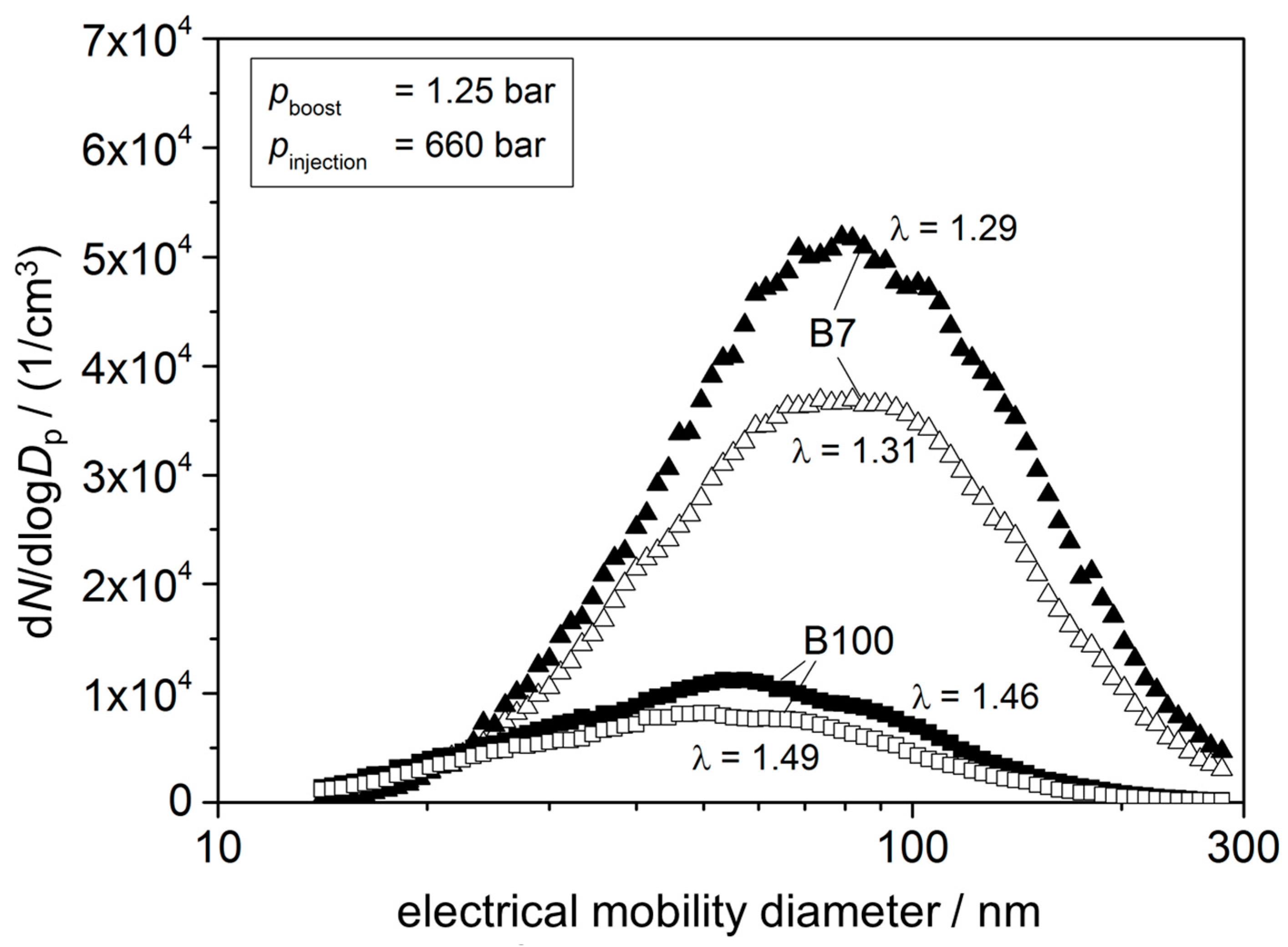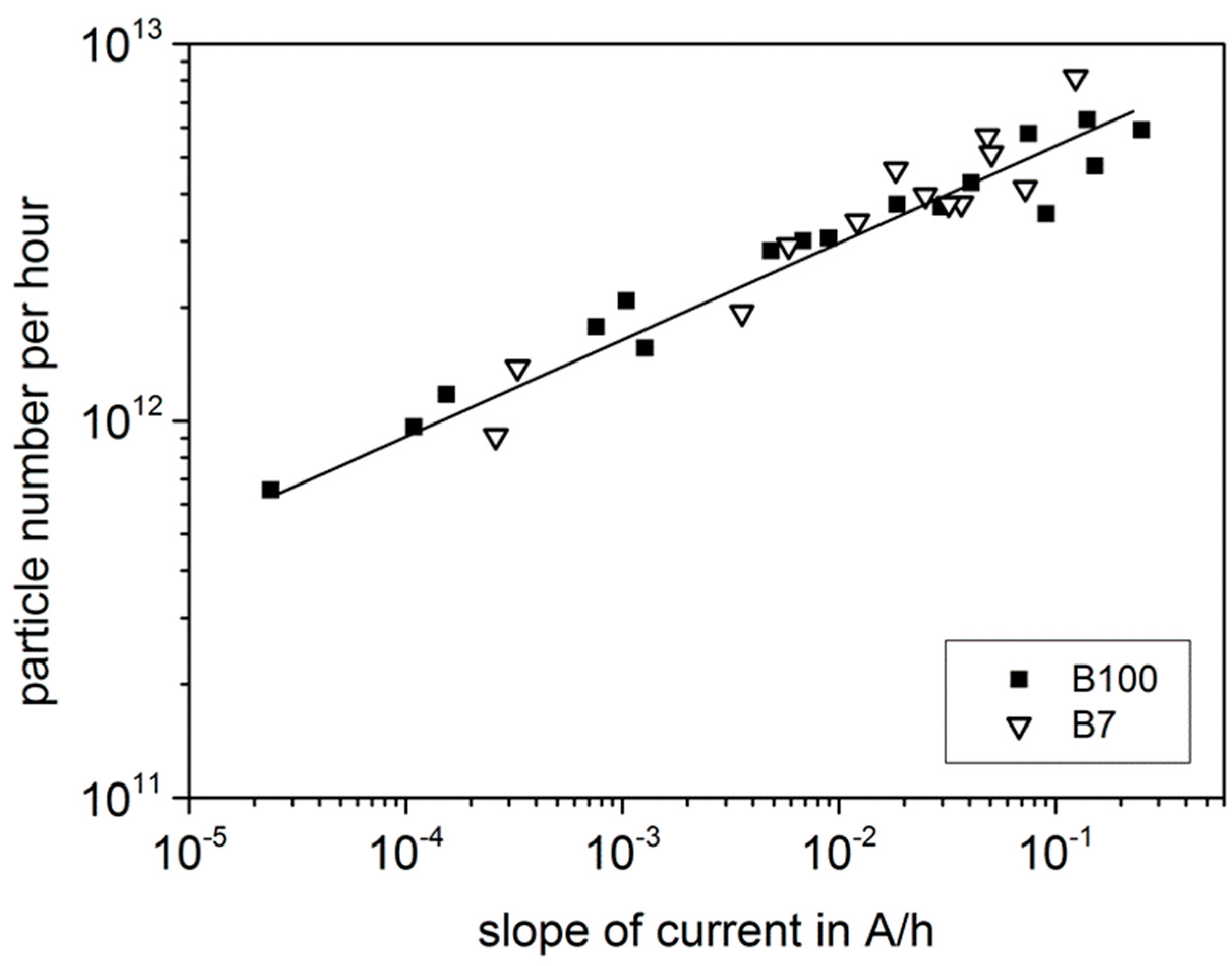Conductometric Sensor for Soot Mass Flow Detection in Exhausts of Internal Combustion Engines
Abstract
:1. Introduction
2. Experimental Section
2.1. Sensor Setup

2.2. General Sensor Characteristics

2.3. Engine Parameters and Analytics


3. Results


4. Conclusions and Outlook
Author Contributions
Conflicts of Interest
References
- Twigg, M.V.; Phillips, P.R. Cleaning the air we breathe—Controlling diesel particulate emissions from passenger cars. Platin. Met. Rev. 2009, 53, 27–34. [Google Scholar] [CrossRef]
- Twigg, M.V. Progress and future challenges in controlling automotive exhaust gas emissions. Appl. Catal. B Environ. 2007, 70, 2–15. [Google Scholar] [CrossRef]
- Rose, D.; Boger, T. Different Approaches to Soot Estimation as Key Requirement for DPF Applications; SAE International: Warrendale, PA, USA, 2009. [Google Scholar]
- Feulner, M.; Hagen, G.; Piontkowski, A.; Müller, A.; Fischerauer, G.; Brüggemann, D.; Moos, R. In-Operation Monitoring of the Soot Load of Diesel Particulate Filters—Initial Tests. Top. Catal. 2013, 56, 483–488. [Google Scholar] [CrossRef]
- Sappok, A.; Bromberg, L.; Parks, J.; Prikhodko, V. Loading and Regeneration Analysis of a Diesel Particulate Filter with a Radio Frequency-Based Sensor; SAE International: Warrendale, PA, USA, 2010. [Google Scholar]
- Fischerauer, G.; Förster, M.; Moos, R. Sensing the Soot Load in Automotive Diesel Particulate Filters by Microwave Methods. Meas. Sci. Technol. 2010, 21. [Google Scholar] [CrossRef]
- Masoudi, M.; Sappok, A. Soot (PM) Sensors. Available online: http://www.dieselnet.com/tech/dpf_soot_sensors.php (accessed on 23 July 2014).
- Hagen, G.; Feistkorn, C.; Wiegärtner, S.; Heinrich, A.; Brüggemann, D.; Moos, R. Conductometric Soot Sensor for Automotive Exhausts: Initial Studies. Sensors 2010, 10, 1589–1598. [Google Scholar] [CrossRef] [PubMed]
- Ochs, T.; Schittenhelm, H.; Genssle, A.; Kamp, B. Particulate Matter Sensor for on Board Diagnostics (OBD) of Diesel Particulate Filters (DPF). SAE Int. J. Fuels Lubr. 2010, 3, 61–69. [Google Scholar] [CrossRef]
- Bartscherer, P.; Moos, R. Improvement of the sensitivity of a conductometric soot sensor by adding a conductive cover layer. J. Sens. Sens. Syst. 2013, 2, 95–102. [Google Scholar] [CrossRef]
- Husted, H.; Roth, G.; Nelson, S.; Hocken, L.; Fulks, G.; Racine, D. Sensing of Particulate Matter for on-Board Diagnosis of Particulate Filters. SAE Int. J. Engines 2012, 5, 235–247. [Google Scholar] [CrossRef]
- Lloyd Spetz, A.; Huotari, J.; Bur, C.; Bjorklund, R.; Lappalainen, J.; Jantunen, H.; Schütze, A.; Andersson, M. Chemical sensor systems for emission control from combustions. Sens. Actuators B Chem. 2013, 187, 184–190. [Google Scholar] [CrossRef]
- Weigl, M.; Roduner, C.; Lauer, T. Partikelfilter-Onboard-Diagnose mittels eines Soot-Sensors nach Partikelfilter. In Proceedings of the 6th International Exhaust Gas and Particulate Emissions Forum, Ludwigsburg, Germany, 9–10 March 2010; pp. 62–69.
- Weigl, M.; Roduner, C.; Lauer, T. Particulate Filter Onboard Diagnostics by Means of a Particulate Sensor. In Proceedings of the FISITA 2010 World Automotive Congress, Budapest, Hungary, 30 May–4 June 2010.
- Brunel, O.; Duault, F.; Lavy, J.; Creff, Y.; Youssef, B. Smart Soot Sensor for Particulate Filter OBD. SAE Int. J. Passeng. Cars Electron. Electr. Syst. 2013, 6, 307–327. [Google Scholar] [CrossRef]
- Marr, I.; Groß, A.; Moos, R. Overview on Conductometric Solid-State Gas Dosimeters. J. Sens. Sens. Syst. 2014, 3, 29–46. [Google Scholar] [CrossRef]
- Müller, N.; Kern, C.; Moos, R.; Jess, A. Direct detection of coking and regeneration of single particles and fixed bed reactors by electrical sensors. Appl. Catal. A Gen. 2010, 382, 254–262. [Google Scholar] [CrossRef]
- Kita, J.; Engelbrecht, A.; Schubert, F.; Groß, A.; Rettig, F.; Moos, R. Some practical points to consider with respect to thermal conductivity and electrical resistivity of ceramic substrates for high-temperature gas sensors. Sens. Actuators B Chem. 2015, 213, 541–546. [Google Scholar] [CrossRef]
- Gill, S.; Turner, D.; Tsolakis, A.; York, A. Controlling Soot formation with Filtered EGR for Diesel and Biodiesel Fuelled Engines. Environ. Sci. Technol. 2012, 46, 4215–4222. [Google Scholar] [CrossRef] [PubMed]
- Teike, G. Untersuchung der Rußanlagerung auf Einem Resistiven Partikelsensor. Ph.D. Thesis, Universität Halle, Wittenberg, Germany, 2011. [Google Scholar]
- Grondin, D.; Breuil, P.; Viricelle, J.P.; Vernoux, P. Development of a particulate matter sensor for diesel engine. Proced. Eng. 2015, 120, 1237–1240. [Google Scholar] [CrossRef]
- Hagen, G.; Müller, A.; Feulner, M.; Schott, A.; Zöllner, C.; Brüggemann, D.; Moos, R. Determination of the soot mass by conductometric soot sensors. Proced. Eng. 2014, 87, 244–247. [Google Scholar] [CrossRef]
- Hagen, G.; Rieß, G.; Schubert, M.; Feulner, M.; Müller, A.; Brüggemann, D.; Moos, R. Capacitive Soot Sensor. Proced. Eng. 2015, 120, 241–244. [Google Scholar] [CrossRef]
- Kondo, A.; Yokoi, S.; Sakurai, T.; Nishikawa, S.; Egami, T.; Tokuda, M.; Sakuma, T. New Particulate Matter Sensor for on Board Diagnosis. SAE Int. J. Engines 2011, 4, 117–125. [Google Scholar] [CrossRef]
- Grob, B.; Schmid, J.; Ivleva, N.P.; Niessner, R. Conductivity for Soot Sensing: Possibilities and Limitations. Anal. Chem. 2012, 84, 3586–3592. [Google Scholar] [CrossRef] [PubMed]
- Malik, A.; Abdulhamid, H.; Pagels, J.; Rissler, J.; Lindskog, M.; Nilsson, P.; Bjorklund, R.; Jozsa, P.; Visser, J.; Spetz, A.; et al. A Potential Soot Mass Determination Method from Resistivity Measurement of Thermophoretically Deposited Soot. Aerosol Sci. Technol. 2011, 45, 284–294. [Google Scholar] [CrossRef]
- Leidenberger, U.; Mühlbauer, W.; Lorenz, S.; Lehmann, S.; Brüggemann, D. Experimental Studies on the Influence of Diesel Engine Operating Parameters on Properties of Emitted Soot Particles. Combust. Sci. Technol. 2012, 184, 1–15. [Google Scholar] [CrossRef]
- Mühlbauer, W.; Leidenberger, U.; Lorenz, S.; Brüggemann, D. Optical Studies about the Influence of Diesel Engine Operating Parameters on the Physicochemical Properties of Emitted Soot Particles. SAE Int. J. Engines 2013, 6, 1866–1876. [Google Scholar] [CrossRef]
© 2015 by the authors; licensee MDPI, Basel, Switzerland. This article is an open access article distributed under the terms and conditions of the Creative Commons Attribution license (http://creativecommons.org/licenses/by/4.0/).
Share and Cite
Feulner, M.; Hagen, G.; Müller, A.; Schott, A.; Zöllner, C.; Brüggemann, D.; Moos, R. Conductometric Sensor for Soot Mass Flow Detection in Exhausts of Internal Combustion Engines. Sensors 2015, 15, 28796-28806. https://doi.org/10.3390/s151128796
Feulner M, Hagen G, Müller A, Schott A, Zöllner C, Brüggemann D, Moos R. Conductometric Sensor for Soot Mass Flow Detection in Exhausts of Internal Combustion Engines. Sensors. 2015; 15(11):28796-28806. https://doi.org/10.3390/s151128796
Chicago/Turabian StyleFeulner, Markus, Gunter Hagen, Andreas Müller, Andreas Schott, Christian Zöllner, Dieter Brüggemann, and Ralf Moos. 2015. "Conductometric Sensor for Soot Mass Flow Detection in Exhausts of Internal Combustion Engines" Sensors 15, no. 11: 28796-28806. https://doi.org/10.3390/s151128796
APA StyleFeulner, M., Hagen, G., Müller, A., Schott, A., Zöllner, C., Brüggemann, D., & Moos, R. (2015). Conductometric Sensor for Soot Mass Flow Detection in Exhausts of Internal Combustion Engines. Sensors, 15(11), 28796-28806. https://doi.org/10.3390/s151128796





